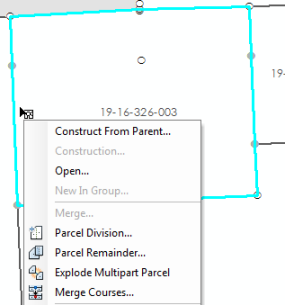Available with Standard or Advanced license.
This topic applies to ArcGIS for Desktop Standard and ArcGIS for Desktop Advanced only.
This workflow describes the steps for splitting parcels using an area description.
The workflow uses the sample dataset downloaded with the Tax Parcel Editing map on the ArcGIS Solutions website. To use the automated workflows on the sample data, enable the parcel fabric in the ParcelEditing feature dataset with the Local Government Information Model and drag the parcel fabric into an empty map document.
The workflow consists of the components shown in the diagram below:

Legal description
A legal description for a parcel split using area may look like this:
The west half of parcel 1916326003; described as T2N, R10E, SEC 16 PART OF E 1/2 OF SW 1/4 BEG AT PT DIST N 89-02-10 W 517.71 FT FROM CEN OF SEC, TH S 00-57-50 E 230 FT, TH N 89-02-10 W 289.25 FT, TH N 00-57-50 W 230 FT, TH S 89-02-10 E 289.25 FT TO BEG EXC N 60 FT TAKEN FOR HWY 1.13 A C145J
Search for parent parcel
- Open the TaxParcelEditingMap document located in the MapsandGeodatabase folder or drag the parcel fabric (enabled with the Local Government Information Model) in the ParcelEditing feature dataset into an empty map document.
- In the Table Of Contents window, make only the Tax Parcels layer and the Tax Lines Anno layer selectable.
- Search for the parent parcel that will be divided. In the sample dataset in the TaxParcelEditingMap document, search for parcel 1916326003.
For this workflow using the sample data, the visibility of the Lots and Units layer and Historic Parcels layer has been turned off.
Select parent parcel
- Start an edit session and use the Select Parcel Features tool
 on the Parcel Editing toolbar to select the parcel you want to divide. In the TaxParcelEditingMap, using the sample dataset, select parcel 19-16-326-003.
on the Parcel Editing toolbar to select the parcel you want to divide. In the TaxParcelEditingMap, using the sample dataset, select parcel 19-16-326-003.
Divide parent parcel
- Right-click the leftmost line of the selected parcel and click Parcel Division.
The Parcel Division command uses the position of the mouse cursor to determine the parcel line to use as the split-line. The parcel line closest to the position of the right-click is used as the split-line. The split-line bearing is the bearing of the line used to divide the parcel.

The leftmost parcel line will be used as the split-line. - On the Parcel Division dialog box, leave the Plan set to the system default <map> plan.
When working with your own data, you would click Plan to choose or create the plan that represents the new parcel.
- Click Template to open the Select Feature Template dialog box and choose the Tax Parcels feature template for the new split parcels.
- Choose by proportional area from the Divide this parcel drop-down list.
- Set the Number of parts to 2.
- Leave the bearing value for the Split-line bearing.
The split-line bearing is the bearing of the line used to divide the parcel. It is the same bearing as the parcel line near which you right-clicked.
- Leave Starting from the set to West.
- Do not choose Activate parcel namer tool when I click OK and click OK to divide the parcel.
The parcel fabric plan represents the legal document recording a parcel merge, subdivision, and so on. Parcels are created in plans. Plans are managed in the Plan Directory dialog box, which is opened by clicking Plan on the Parcel Details dialog box.

Annotate parcels
- If necessary, close or dock the Parcel Details dialog box.
- Make sure the Tax Lines Anno layer is turned on in the Table Of Contents window.
- With the new parcels selected, click the Annotate Parcel Courses tool
 on the Parcel Editor toolbar.
on the Parcel Editor toolbar. - Select ParcelDimensions - 1:1200 on the Annotate Selected Features dialog box and click OK.
Click Yes to re-create annotation.
- If necessary, use the Edit Annotation Tool
 to edit and change the placement of the generated annotation.
to edit and change the placement of the generated annotation.
In the TaxParcelEditingMap document, new annotation is not automatically created when new parcels are added.
Annotation is created using the Annotate Parcel Courses tool  , which handles the duplication of annotation on parcel lines.
, which handles the duplication of annotation on parcel lines.
Attribute parcels
The final step in the workflow is to update the attributes of the new parcels:
- Use the selection chip to select the new, divided parcels and open the Attributes window.
- Select a parcel from the parcel list under Tax Parcels and update attributes such as the Parcel Identification Number, StatedArea, LegalStartDate, and Accuracy.
The LegalStartDate attribute should correspond to the date on the parcel's plan. If the Accuracy attribute is left empty, the value is inherited internally from the plan accuracy. You can override the plan accuracy by specifying a different parcel accuracy. Accuracy values are used in the parcel fabric least-squares adjustment.
- Update the attributes of the remaining parcels in the list.
- Optionally update the attributes of the historic parcels:
- Turn on the Historic Parcels layer in the Table Of Contents window.
- Use the selection chip to select the historic parcel in the map.
- Open the Parcel Details dialog box and update attributes such as LegalStartDate, LegalEndDate, and Reason Parcel Retired.